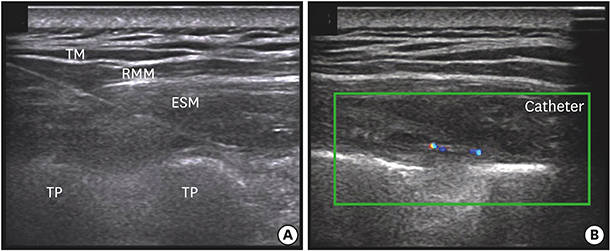


Journal List > J Korean Med Sci > v.33(45) > 1107938



 | Fig. 1Surgical incision and technique of the ESPB. Total mastectomy with sentinel lymph node dissection was performed (A). The level of the T5 rib and TP was located using a counting-down approach from the first rib; this was marked on the skin (B). After placing a 5–12 MHz linear probe parallel to the vertebral axis, a needle was inserted, in a caudad-to-cephalad direction, toward the TP of T5 (C). Then, the catheter was inserted and secured by suture to the skin (D).ESPB = erector spinae plane block, TP = transverse process.
For photographs and medical records that consisted possible identification of the patient, a consent form was obtained from the patient for use of publication.
|
 | Fig. 2Ultrasound-guided ESPB. A tuohy needle was inserted to contact the TP (A). After confirming proper position of the needle, a 19-G epidural catheter was inserted above 2 cm via real-time US guidance (B).ESPB = erector spinae plane block, TM = trapezius muscle, RMM = rhomboid major muscle, ESM = erector spinae muscle, TP = transverse process, US = ultrasound.
For photographs and medical records that consisted possible identification of the patient, a consent form was obtained from the patient for use of publication.
|
 | Fig. 3Schematic diagram. Local anesthetic was injected between the erector spinae muscle and transverse process, and spread to the thoracic vertebral and intercostal space via bony gaps, such as the costotransverse foramen. Additionally, local anesthetic will pass through fenestrations in the costotransverse ligament, reaching the nerve root in the paravertebral space.TP = transverse process, ESM = erector spinae muscle, RMM = rhomboid major muscle, TM = trapezius muscle.
|
Woo Jin Kwon 
https://orcid.org/0000-0001-6806-5677
Seung Uk Bang 
https://orcid.org/0000-0001-6609-7691
Woo Young Sun 
https://orcid.org/0000-0002-5447-4266